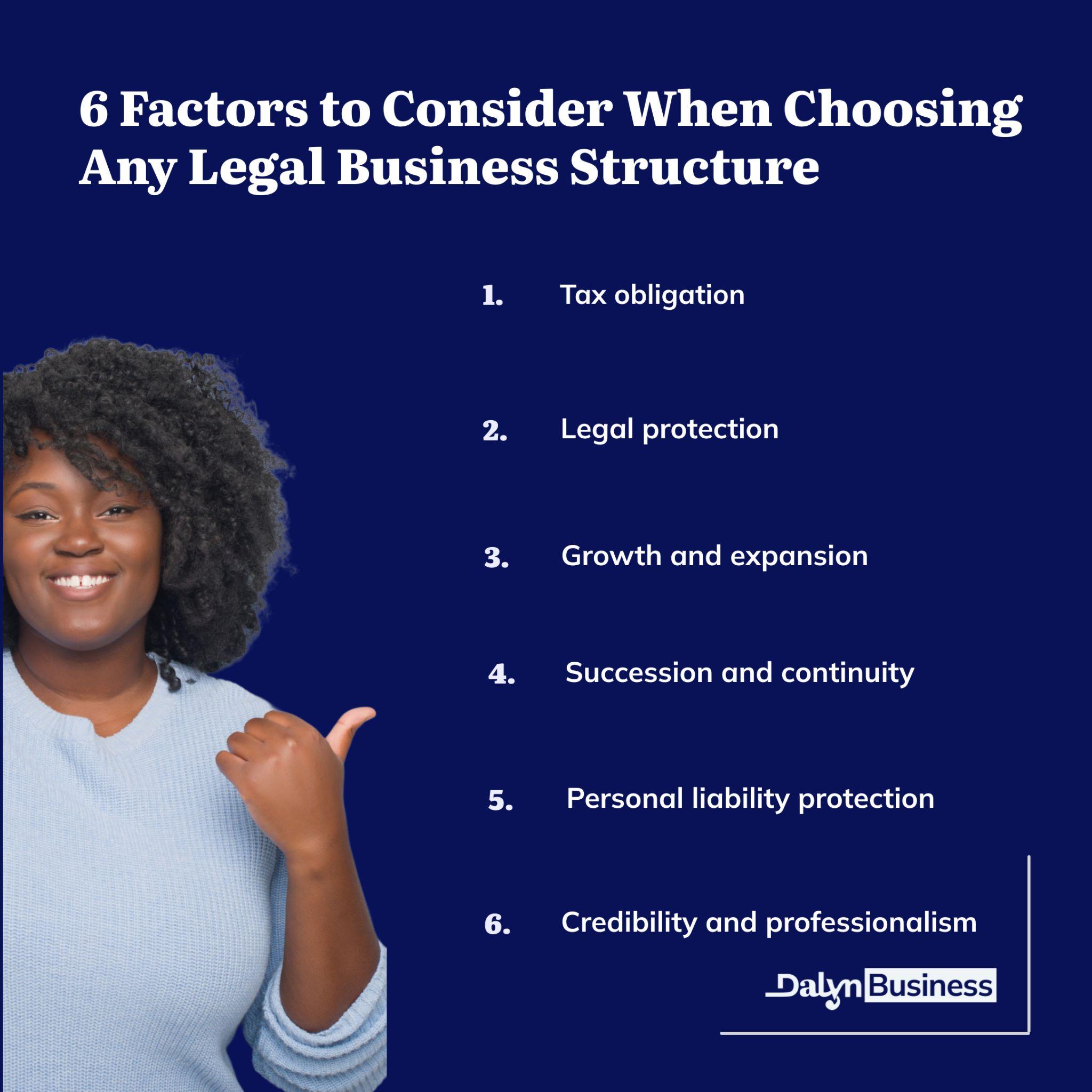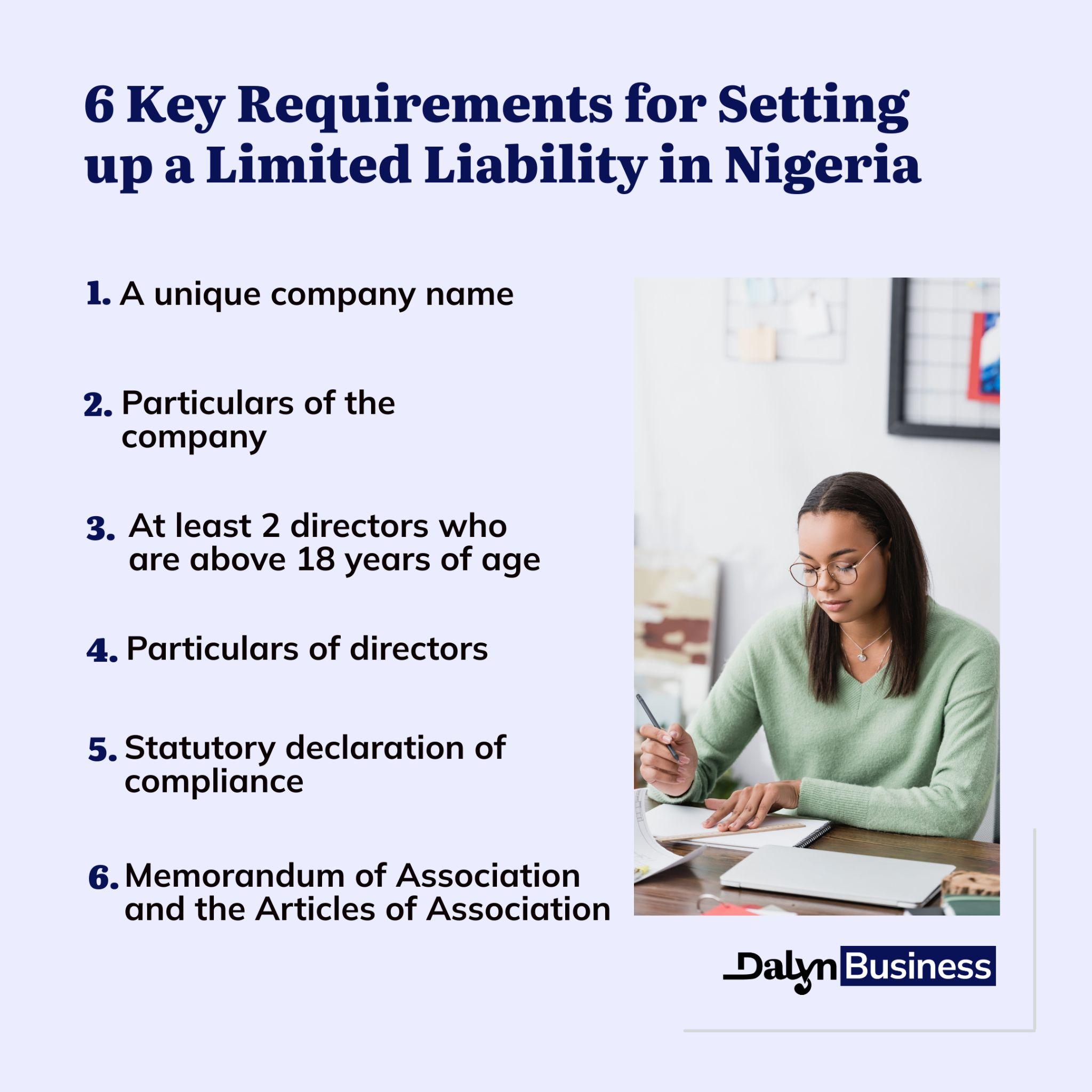Choosing the right legal structure for your small business can be challenging. Either you get confused when you hear the term, “business structure,” or you don’t know how to choose the one that best works for your small business.
But it doesn’t have to be. This guide will explain everything you need to know about a business structure. You’ll also learn about the three legal structures you can choose from as a small business owner or an aspiring business owner in Nigeria. They include:
- Sole proprietorship
- Partnership
- Limited liability company.
At the end of this article, you’ll know what a business structure is as well as how you can choose the one that best suits your small business in terms of legal protection, tax obligation, personal liability protection, credibility and professionalism, growth and expansion, and succession and continuity.
What is a business structure?
Odiri Lana Imevbore, a Nigerian business lawyer, defines a business structure as “the legal structure of your business that tells you how your business is being organised and your day-to-day affairs.” It is the legal framework that guides you on how you’ll set up and run your business.
A business structure is like the human skeleton. As the skeleton gives shape to the human body, a business structure gives shape to a business. This means that setting up a business structure is essential because it clearly defines every role and responsibility in the business to make it run smoothly. It dictates who’s in charge, the formula for sharing money, how decisions are made, the tax to be paid, and how shareholders will be admitted into the business.
There are 3 legal business structures you can choose from for your small business. They include:
- Sole proprietorship
- Partnership
- Limited liability company.
Your choice of a particular structure depends on the nature of the business that you want to start.
Why you need to have a business structure
Some of the benefits you’ll enjoy from setting up a legal structure for your business include:
- Legitimacy: Setting up a business structure gives your business the legal authority to operate within a state or country. This will make customers and prospective investors find your business trustworthy to patronise.

- Operational flexibility: Certain legal structures, such as partnership and limited liability companies, are flexible in the aspects of making decisions concerning the business, stating how the business will be managed, and admitting or removing members. For instance, imagine you’re a shareholder in Brian Cosmetics Ltd. You and the other shareholders can decide to sell off some of the shares of Brian Cosmetics Ltd to the public to attract investors to the business. The board of directors can also agree to conduct an election to choose new heads of the company. This flexibility gives your business the opportunity to adapt to changing circumstances and ease the rate of its growth.
- Growth and expansion: The Guardian Newspaper has it that setting up a business structure will give you the “liberty to think freely about the future of your business without worrying so much about the present.” This means that a business structure safeguards the future of your business. A legal structure increases your chances of getting loans and grants from the government, banks, and other lending facilities to expand your business. It can also make it easy for your business to attract potential investors who have grown to trust you for the way your business is properly structured.
- Limited liability protection: Setting up a legal structure, such as a limited liability company, protects your personal assets from every form of legal issue or debt against the business. For instance, if a customer goes to court to file a lawsuit for buying an expired product from you. He can only sue the company as an entity and not you as one of its shareholders. Any damage claim from the lawsuit will be paid from the company purse and not from your personal savings or assets.
Types of legal business structures in Nigeria
While there are other types of business structures, we’ll cover sole proprietorship, partnership, and limited liability companies because they’re ideal for small businesses in Nigeria.
1. Sole proprietorship
In sole proprietorship, one person owns and manages a business registered under it. As a sole proprietor, you start, fund, and manage your small business all by yourself.
Factors to consider when choosing the sole proprietorship legal structure
- Legal protection: This legal structure does not provide any protection for your personal assets, such as money and properties. This is because you and your business are not separate entities. You are your business and your business is you.
- Tax obligation: As a sole proprietor, your business is governed by a type of tax called personal income tax. A personal income tax is the type of tax that you pay in respect of the amount you earn as income. You pay this tax because your money and that of the business are one and the same.
You also enjoy a tax pass-through. This means that you pay personal taxes instead of business taxes.
- Credibility and professionalism: Before potential investors and customers, a business under sole proprietorship is considered to be less formal and less credible when compared to a partnership and limited liability company. They might prefer trusting a business that is considered to be more established because it is managed by more than one person.
- Growth and expansion: This legal structure has limitations when it comes to growth and expansion. As the owner and manager of the business, you might face some challenges when you try to raise capital or attract investors to your business. This is because what you have at your disposal is only your small network and limited funds.

- Personal liability protection: This structure does not guarantee limited liability protection for the personal assets of the owner. That is to say that as a sole proprietor, your personal assets, such as your savings, investment and property, are at risk if your business faces financial difficulties, liabilities or lawsuits. For instance, let’s say you have a supermarket where you sell baby clothes and you incur some debt that you’re unable to pay. When your creditors file a lawsuit against you, your personal assets can be used to offset the business debt that you incurred.
- Succession and continuity: Your business faces some challenges with continuity and succession. It may end when you retire or die when “there is no express agreement to continue the business.”

Advantages of a sole proprietorship legal structure
The following are some advantages of sole proprietorship.
- You’re the only one that enjoys the profits made from the business as the sole owner and manager.
- It’s straightforward and inexpensive to set up. It’s not costly when compared to limited liability companies and partnerships.
- You have full control of the business. This makes it easy for you to make business decisions quickly.
- You’re also excused from the huge taxes levied on businesses under limited liability companies.
Disadvantages of a sole proprietorship legal structure
As a sole proprietor, you face the following disadvantages.
- Your personal assets are a risk in situations where your business faces risks or lawsuits.
- Your limited resources and abilities can limit the growth rate of the business. And a business managed by one person can shy away investors.
- When compared to businesses set up under partnership and limited liability companies, a one-person business is most prone to shut down. This is because it has no clear succession and continuity plan, and the death, retirement, or incapacitation of the owner can lead to the end of the business.
2. Partnership legal business structure
Omolayo Olorunsola, a business lawyer and CAC Incorporation Expert defines partnership legal structure as “the type of business relationship where two or more persons come together to put their resources together and manage a business with the sole aim of sharing and making profits.” This is a legal structure where people come together to start a business and share its responsibilities.

The number of people allowed to run a business partnership is between 2-20. So, according to the 1890 Partnership Act 1(1), a partnership becomes illegal if it exceeds 20 people.
Factors to consider when choosing the partnership legal structure
- Legal protection: The type of legal protection that you and your partners will get depends on the nature of the partnership. When you set up a General partnership, you and your partners will be like sole proprietors who are not different from their businesses. This means that your personal assets are tied to the business. But in a limited liability partnership, you and your partners are separated from any business challenges or lawsuits against the business.
- Tax obligation: When it comes to the taxation law in partnership legal structure, Eyitayo Ogunyemi, a Nigerian business lawyer, say that just like in sole proprietorship, taxes paid by the partners “are subject to the Personal Income Tax Act (PITA).” This means that the income generated from the business under this is passed through to each partner. So each partner is responsible for paying all taxes from their share of the business profit. But this still varies according to their financial commitments, mutual understanding, and binding contract.
- Credibility and professionalism: When your business under a partnership legal structure has a well-crafted and clear partnership agreement, which clearly maps out the roles and responsibilities of each partner, it’ll increase its reputation in the eyes of investors and customers.
- Growth and expansion: Because you’re managing the business with one or other people with diverse knowledge, network, and resources, there’s an increased chance for growth and expansion when compared to sole proprietorship. There is also an opportunity to admit new partners into the business.
- Personal liability protection: If you set up your business under a General partnership, your assets have no limited liability protection from any debts or legal issues that the business may incur. In the case of a limited liability partnership or limited partnership, your personal assets are protected from business losses like lawsuits or debt.
- Succession and continuity: This is clearly stated in the partnership agreement to take care of admitting and removing partners. There’s also a section that tackles how ownership interests are shared at the death, retirement, or incapacitation of any partners.

Advantages of partnership legal structure
Some of the advantages of this business structure are that:
- Unlike a sole proprietorship, businesses under a partnership legal business structure appear more credible and trustworthy by customers, suppliers, and investors. This increases the business’s chance for growth and expansion.
- The partners combine their resources, skills, and expertise to further give the business room for growth.
- It has a planned and organised means of expansion and succession which is outlined in the partnership agreement.
Disadvantages of a partnership legal structure
- Although you and your partners share responsibilities and resources to run the business, there can be conflicts and disagreements during decision-making.
- Kingsley Izimah, a Nigerian business and corporate lawyer believes that one of the disadvantages of partnership legal structure is the lack of trust that might come up among partners, especially when it comes to money and property.
- While there’s a written means of succession and continuity, the death or departure of one partner is a great risk to the business.
- Sharing of income by the partners leads to lower income per partner.
- Disagreement among partners can affect the smooth operations of the business.
3. Limited liability company (LTDs)
This is a type of legal structure where more than two individuals come together to start a business while enjoying the benefits of a partnership and a corporation. This structure protects the personal assets of the members from the debts and liabilities of the business. This means that when the business faces legal or financial troubles, the members’ personal assets will not be at risk.

Factors to consider when choosing the limited liability business structure
- Legal protection: This shows that the company is a separate legal entity that should tackle every form of legal obligation against it. Legal duties can come in the form of tax payments and lawsuits. But they can still opt for a pass-through taxation system where members pay taxes based on their shares and profits.
- Tax obligation: There’s flexibility for tax payment in this structure and the type of tax they pay is company income tax. This means that the business is taxed (based on the company profits) and not the shareholders of the company.
- Credibility and professionalism: Potential investors and customers consider LTDs as most credible and formal. Lawpadi believes that this is because “it suggests to the world that the business has permanence and is committed to effective and responsible management.” The business is also seen as more structured, organised, and trustworthy.
- Growth and expansion: There is flexibility in the number of members that are admitted to a business under this legal structure. And, it is easy for both the starting and admitted shareholders/members to combine their resources, expertise, and networks to improve the chances of growth and expansion of the business. They can also accommodate different business needs, such as increasing the services that they offer, employing new staff, or opening new branches.
- Personal liability protection: Unlike sole proprietorship and partnership, LTDs grant their members limited liability protection for all their assets. This shows that they only lose their financial commitments in the case of company legal obligations. All their assets remain secured.
- Succession and continuity: The shareholders of a business can draft a written agreement about the sale and transfer of shares or interests. This will ensure the continuity of the company in cases of retirement, incapacitation, or death of any shareholder.

Advantages of a limited liability legal structure
- The limited liability business structure appears more formal and credible in the eyes of investors and customers than partnership and sole proprietorship. This is because it’s considered more organised with its many expertise and skills.
- There are more capable hands to grow the business.
- It has flexibility of growth and expansion. Members can bring in new members, issue new share ownership, or choose to raise capital among themselves for the easy expansion of the business.
- The demise or exit of one person has no significant negative impact on the business. There’s already a provision for the transfer or sale of shares and interests written down in the memorandum of association and articles of association (M&A).
Disadvantages of a limited liability legal structure
- It has a more complicated decision-making process. The opinions and approvals of many shareholders and directors will be sought before taking the most simple decisions. This can cause delays in the business.
- The cost of setting this up is higher because of the much paperwork involved.
How to choose the best structure for your business
When choosing the legal structure for your business, it is important that you keep these in mind.
1. Your business goals
These are targets you want to meet for your business over a certain period. They are the things that you set your mind to achieve in your business.
Your goals can be long-term or short-term. Long-term goals go from one year to a number of years, while short-term goals range from hours to a year. While short-term goals are considered to be the building blocks of long-term goals, long-term goals are those goals you target to achieve in the future.
Assuming you’re a fashion designer, your long-term goals can be to:
- Have different branches for your fashion business.
- Partner with celebrities and popular influencers to increase the visibility of your fashion brand.
- Become a global name in the fashion industry.
Then, your short-term goals can be to:
- Create a compelling and attractive logo that will go well with your brand identity and improve your marketing strategy.
- Improve your customer satisfaction strategy and grow more loyal customers.
- Take part in fashion shows and events to showcase your designs to a wider audience.
It is crucial that you consider your business goals before choosing a legal structure. Setting up a legal structure that resonates with your business goals will help you reach your business targets faster.

If your business goal is to start small and grow your business without any third-party interference, you can choose sole proprietorship.
If your long-term goal is to get legal protection for your assets or to attract investors with ease, a limited liability structure is your best shot. Let’s assume you want to open a rice mill with other people, but you have the goal of securing your assets from potential risks that might come into the business. Then set up the business as a limited liability company. This will ensure that your personal assets are not affected in cases of business risks.
You can go for partnership if your goal is to combine your resources with one or two colleagues to start the business. With this, you can merge your skills and expertise as well as share responsibilities for the growth of the business. Assuming your goal is to start a law firm, you can collaborate with a friend to set up the business with a binding partnership agreement. These combined efforts can easily increase the success rate of the business.
2. The legal costs of setting up the structure
You need to consider the expenses involved in setting up each legal structure. The expenses include registering the business with the Corporate Affairs Commission (CAC) and applying for the needed business permits related to your industry. For example, you get your business permits from the National Agency for Food and Drug Administration and Control (NAFDAC) if you’re in the food industry.
Considering this is important because various legal structures have peculiar costs and requirements. When you consider the costs that come with setting up each legal structure,
- You will be able to consider both the benefits and disadvantages of each legal structure.
- It’ll help you plan how to better manage your business funds according to your budget.
- You’ll avoid unnecessary financial burdens that might come with paying legal fees that outweigh your business funds.

If you’re a one-man business owner with limited business funds, consider sole proprietorship as it is the cheapest and easiest to set up. It also comes with little paperwork, such as:
- Searching for the availability of the name
- Making a reservation for your business name
- Registering the business.
Other legal costs required here come with applying for your tax identification number and getting the relevant business permits.
In partnerships, you spend a little extra. This is because you’ll need to hire a lawyer to draft your partnership deed/agreement. A partnership deed is a written legal document that contains the rights, duties, and responsibilities of the partners involved in the business. It’s like a binding contract that outlines the rules guiding the partnership: for instance, how profits and losses are to be shared, how much each partner invests in the business, and the decision-making process.
If you intend to set up a business as a limited liability company, you’ll spend more on legal charges. The charges are for drafting and documenting all the incorporation documents, such as Memorandum and Articles of Association (M&A). M&A are legal documents that contain the rules and details of a corporation or company. Under a limited liability company, you’ll also pay more to register for a company name with CAC, apply for your tax identification number, and other business licenses.
3. Your control margin
This is your level of control and the decision-making power you have in your business. Considering the level of your control margin will help determine the level of involvement you’ll like to have in your business. And this impacts your decision-making power.
As a sole proprietor, you can make decisions about your business easily. This is because you have 100% control over the business.
Limited liability legal companies have a more complicated decision-making process than the other two. All the members contribute their share before the company takes any action. In this case, all the partners have a say in every decision concerning the business.
Going back to our law firm business example, you will share equal rights to control the business with your partners based on the terms of their partnership deeds. Your control margin is a bit limited and you will have to seek approval from all the partners before taking any action regarding the business.
4. The requirements expected
This refers to the various legal duties that you need to fulfil as a business owner in Nigeria. These include the licenses, conditions, documentation, and registration needed to set up each structure to ensure that your business operates smoothly.
Considering the legal requirements for setting up each structure will help you to understand them and choose the best legal structure. If you fail to meet these needed requirements, you might incur government wrath, penalties, or even business closure.
For instance, the sole proprietorship structure has straightforward and fewer requirements than the partnership and limited liability structures. The requirements for setting up your business as a sole proprietor include:
- A business name registered with the Corporate Affairs Commission (CAC)
- A Tax Identification Number which the Federal Inland Revenue Service (FIRS) will issue
- A business account
- Relevant business permits/licences
- Value Added Tax (VAT): You will get this if your business starts getting an annual turnover level that is more than N5,000,000.

Setting up a partnership legal structure for your business requires the same documentation as in a sole proprietorship. But you’ll also need a partnership deed/agreement.
Limited liability company, for its part, has more rigorous requirements. Ọdịri Lana Imevbore outlined some of the requirements for setting up a limited liability company. Some of them are:
- A unique company name
- Particulars of the company
- At least 2 directors who are above 18 years of age
- Particulars of directors
- Personal name
- Address
- Date of birth
- Contact number and email
- Gender
- Sharing formula of the share capital depending on the agreement of the directors involved.
- Statutory declaration of compliance according to the requirements of the Company and Allied Matters Act (CAMA) 2020: Statutory declaration of compliance is a document that assures CAC that you’ll fulfil all the rules of CAMA 2020 concerning managing a company in Nigeria. It should be signed by a notary public commissioner support or a legal practitioner.
- Memorandum of Association and the Articles of Association (M&A): A Memorandum of Association takes care of the functions, shares, and objectives of the company. Articles of Association cover the rules and regulations guiding the company.

5. The number of people starting the business
This refers to the number of people that are to start and grow the business in the manner of co-owners or partners. Knowing the number of people starting a business will help you to determine the right legal structure that can support and accommodate the desired ownership and management structure.
Sole proprietorship is ideal for you if you want to start and grow a business by yourself. You have 100% control of the business, including all its managerial decisions.
If you’re starting the business with one or more colleagues, you can go for the partnership business structure. Here, both the profits, losses, taxes, and other managerial decisions are shared among you and your partners as outlined in the partnership deed.
In the case of flexibility with starting and running a business with one or more persons, you can go for LTD. That is, it’s possible to add or remove shareholders to the company as it grows. The members share the profits, losses, taxation, and other managerial responsibilities. But, unlike in partnership, the shareholders in LTDs have their assets secured from all forms of potential business risks.
6. The profit sharing
Profit sharing is how profits are shared among the business owners. This talks about how the gains made in the business are divided among the people who invested in the business.
The profit-sharing formula is normally determined based on the roles, responsibilities, and financial commitment of each individual in the business.

Let’s assume that you and your friend decide to combine funds and expertise to start a catering business. You invest 70% funds of the share capital and your friend invests 30%. As the business starts yielding profits, the sharing formula will be mapped out in a way that 70% of profits go to you while 30% goes to your friend.
Considering the profit-sharing formula of your business when choosing a legal structure will help determine how much return on investment you’ll be expecting from the business.
If you don’t intend to share your profits with a third party, then consider sole proprietorship. This means you’ll bear all the financial responsibilities in the business, and you’re the only one entitled to the business gains. Also, you can use the business income as it pleases you without any external interference.
Profit sharing in partnership is according to the terms of the partnership agreement. The partners may decide to share the business profits equally or based on an agreed formula.
In the case of LTDs, profit sharing is flexible as in the partnership legal structure. The shareholders deliberate and agree on the manner of profit sharing in the business. They can choose to share it on their level of involvement or financial contribution in the business.
7. Liability Protection
Liability protection refers to the extent to which you’ll involve your personal assets when managing business difficulties and business legal issues. It’ll determine the level to which you’ll involve yourself and personal funds in sorting out unforeseen business losses, such as settling debts, being sued, and suing people.
Considering the extent to which your personal assets get protection from business losses and legal obligations will help you prepare yourself beforehand to manage and secure your personal assets. Above all, it’ll help you choose a business structure that can guarantee the safety of your assets.
Limited liability structure favours business owners because there’s a high level of protection for their assets from business risks and lawsuits. The owners of the company, known as shareholders, have no personal stake in any legal claims or losses encountered in the business. This is because the only money they’ll lose in cases of business liabilities or lawsuits is the money they invested in the business.
But this doesn’t count if there’s clear evidence of fraud and improper mixing up of business and personal assets. For instance, you and your friends, Dele and Godwin, decide to open and register a shoe production company called Men’s Love Nigerian LTD. Three of you are shareholders in the company. Then, Godwin decides to use the company name for fraudulent activities and also misuse company funds for his personal use. In this case, when the Economic and Financial Crimes Commission (EFCC) and the people he defrauded catch up with him, they’ll sue him and his assets. In this case, Godwin is personally responsible for the damages caused by his fraudulent acts.
Limited liability protection of personal assets is not the same in partnership and sole proprietorship which expose the personal assets of business owners to risks in the face of business losses and lawsuits. The business owners and their businesses are the same in the eyes of the law.

Assuming you want to start a cake-baking business and you want to register your business under the sole proprietorship legal structure, you’re your business and your business is you. So, if you owe someone or you borrow money from the bank, they’ll sue both your personal assets and your business assets. Your personal assets can be seized by your creditors to settle your business debts. This is what is considered to be an unlimited personal liability to business lawsuits and debts.
This situation is not different from what will happen if you decide to set up a partnership legal structure for your business: for example, a tech business. If there comes a time when you and your business partners can’t pay your debts, the amount involved will be shared among all the partners. They’re expected to offset the debt with their personal funds. Any lawsuit that the business gets, the lawsuit is not on the business alone, but you and your partners are sued as well.
Conclusion
Setting up the right structure for your business is essential for its success. As a small business owner, you’ll need to make your choice among the 3 legal structures outlined in this article: sole proprietorship, partnership, or limited liability legal structures.
Remember the important factors for choosing the right business structure for your business, such as the cost of each structure, personal liability protection, profit-sharing formula, etc. Taking note of them as already discussed in this guide will guarantee the smooth operation of your business.




